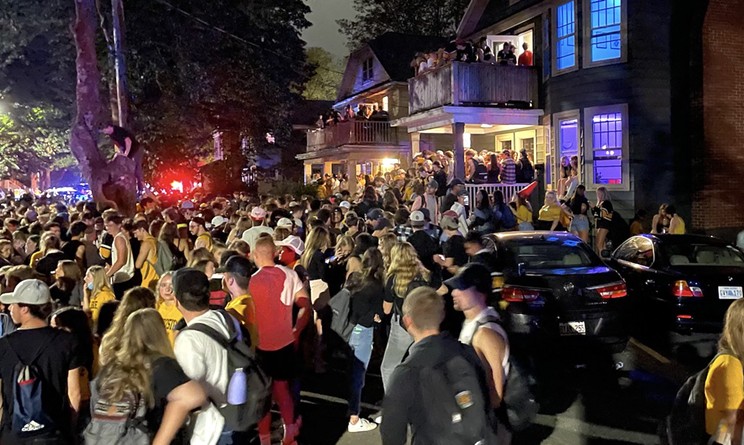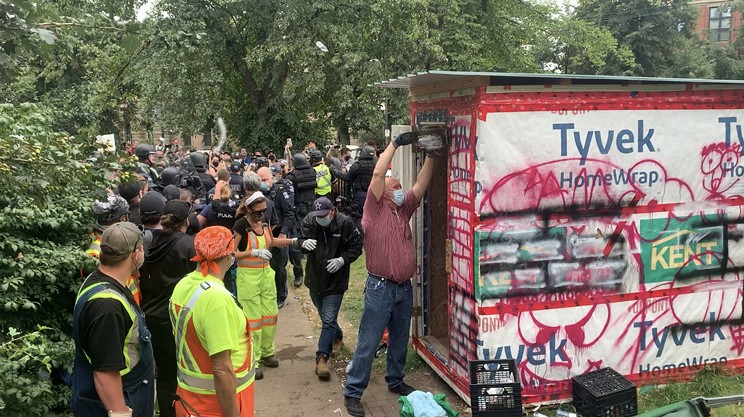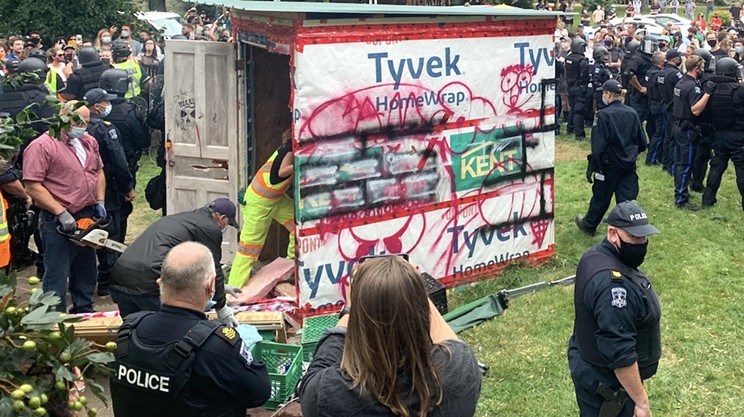On Saturday night, a few residential city blocks between Coburg and Jubilee Roads were unlike any other. Busier than Pizza Corner after the bars close, bodies packed tighter than Christmas at the Forum in pre-COVID times. But rather than waiting for poutine or shopping for gifts, these people were Dalhousie (and probably King’s and SMU and MSVU and NSCC) students getting, well, lit for homecoming weekend. In this drunken mob red Solo cups abounded, polo shirts in black and yellow (Dal’s official school colours) were the unofficial uniform and paramedics were on scene to carry at least one person away in a stretcher after they HoCo’d a little too close to the sun.
It didn’t take long for social media to erupt in criticism—of students for partying too hard, Dalhousie for “letting” them party, police for not doing enough, neighbours for basically yelling “get off my lawn” and back to students again for possibly spreading COVID. Here are six reasons why the HoCOVID party was an occasion to make everyone mad.
There goes the neighbourhood
The aggrieved
Residents
The blamed
Students, Dalhousie University, police
The problem
In 2017, a large party on Jennings Street to mark Dalhousie’s “homecoming weekend” resulted in 22 arrests. In the aftermath, neighbours and community members met at Dalhousie to discuss disciplinary actions and restoring trust in the community. So when the time came around again for the 2021 HoCo party (even though there was no actual HoCo football game or any alumni events beyond the dental school), Halifax police issued a warning they’d be patrolling the neighbourhood on the weekend.
2 ambulances on site and maybe 8 police cars (and a horse) around 2:30. Level of intoxication was pretty wild. Hope all are safe - a lot more “darty” to go… pic.twitter.com/3rkAJoYJol
— Whittaker, GR (@Geewhit) September 25, 2021
Police were on site at Saturday’s party (more on that in a minute), but it doesn’t seem like their presence eliminated misbehaviour. On Snapchat, students were seen doing head-first dives off trees into the crowd, which stretched as far as could be seen in any direction. On Twitter, residents posted about knocked-over flower boxes and basketball nets; vomit and empty bottles strewn across the sidewalk; and their fears that the event was sure to be a COVID superspreader.
Then this plus lots of screaming around 1:30 am. @DalSecurity this is not “socializing” and neighbours are tired of it. @DalGazette @DalStudentLife @DalhousieU @CBCNS @portiaclarkcbc pic.twitter.com/l2aVIaI2sI
— Peggy Walt (@pwalty) September 25, 2021
The solution
There are clear reasons why the annual HoCo party has been a concern for community members, but each side needs to compromise. Dalhousie and its students need to rebuild their fraught relationship with the community, and south end residents need to realize they live beside a school of thousands of youth who haven’t seen their classmates in 18 months. Forget about “students” versus “residents” for a sec. If this was trouble between neighbours—and it is—the first step of a genuine apology from the boorish folks who made a drunken mess would be accepted with grace (step two) by irritated householders, then everybody could get back to the work of figuring out how to live together.
Parties, privilege and protest
The aggrieved
Justice
The blamed
Police, city council
The problem
Last month, Halifax Regional Police turned out with riot gear and pepper spray at the old Spring Garden Memorial Library. Citizens had gathered to support their unhoused neighbours living on the library grounds, by protesting their eviction by police. During the events, 24 people were arrested, a disproportionately large number of them queer and BIPOC Haligonians. Police also threw protesters to the ground, obscured their identities by removing the nametags from their uniforms and tried to order journalists to leave. In contrast, no footage has surfaced of police violently arresting anyone at the Dalhousie party, and in photos of the scene officers seem comfortable to be witnessed on the job.
While we can’t assume that all students at HoCOVID were privileged, white and/or straight, comparing the party and the protest shows a definite difference in the way the city reacts to a group of people blowing off steam and the way it reacts to people standing up for what they believe in. That difference extends to the reaction from city councillors, who were noticeably quiet on social media in the days following the crisis shelter evictions. However, when dealing with complaints from neighbours about beer cans on sidewalks and loud music, councillors assured their tax-paying, house-owning constituents they would get right on that.
Good morning! Just omn GlobalTV to talk about Dal street parties and next steps, meeting Iona Stoddard this morning, then Wendy Luther, chatting with Dal and MLA Lisa Lachance, getting update by police, and talking to HRM staff about next steps.
— Waye Mason (@WayeMason) September 27, 2021
The solution
Police need to serve the community equally, and if that means HRP is arresting protesters defending their fellow citizens, that certainly means breaking up a neighbourhood-disturbing party even if it’s full of tuition-paying 20somethings who are ostensibly just having fun. Both HRP and council need to address community members’ concerns, whether they are wealthy, white and whining, or living on the margins of society.
All gatherings aren’t created equal
The aggrieved
Students, Dalhousie
The blamed
COVID regulations
The problem
Something like 1,000 students attended the HoCOVID party on Saturday (official numbers are hard to come by) and became the target of national opprobrium. But just a few days earlier, on Wednesday evening, a crowd of 6,413 people packed into the Wanderers Grounds stadium for a soccer game and earned praise for generating a “festival-style celebration [that] showed the long awaited enthusiasm of sports fans to return to live games after a tough 18 months.”
6413 of us together again 💙
— HFX Wanderers FC (@HFXWanderersFC) September 22, 2021
Thank you Halifax. Sold out crowd and new attendance record.#TogetherWeAreHome pic.twitter.com/xmbo6CCtzk
Sure, there were key differences between the events. The party was unorganized and unregulated, sprawling from the early afternoon until the wee hours of the morning with no masks in sight. Getting into the game required proof of vaccination at the door, seating was assigned and attendees had to wear masks unless they were drinking or eating. But still, it’s hard to believe a gathering of 1,000 people is the end of the COVID world when we’re apparently fine with more than 6,000 partying together.
And the epilogue to the Wanderers game: a negative result from a COVID-19 take-home test. Even with a crowd of 6,413, we’re not being foolish! pic.twitter.com/3IrWubuP8w
— Denton Froese (@Labville) September 23, 2021
There are more and more large events happening around Halifax lately. The Hopscotch Arts Festival brought large swaths of people to Parade Square for nightly concerts, and the School Strike for Climate protest on Friday also brought out hundreds of youth. While the events are all quite different, there’s no doubt there’s some overlap in attendees, and no one is asking all the soccer superfans to get swabbed.
The solution
The Nova Scotia government has yet to fully implement its proof of vaccination program, which is currently slated to come into effect on October 4. Confusion from unclear guidelines and the Phase 5 delay may have led students not to mask up at the party. But an official POV system could help unmuddy the waters, if party and event organizers are willing to consistently check for it. And public health should make it recommended, if not mandatory, that anyone attending a large event get a COVID test before and after.
Superspreading in the fourth wave
The aggrieved
Nova Scotians
The blamed
Students, police
The problem
Last spring, a single house party on Jubilee Road generated 22 illegal-gathering tickets and blistering condemnation from then-premier Iain Rankin. So when Halifax Regional Police showed up at the party on Saturday afternoon, it was fair to assume COVID violations would soon be issued in the dozens. But that was far from the case. Police only made a few public intoxication arrests—10 of them total. HRP also says “numerous” summary offence tickets for open alcohol were issued.
Nova Scotians who weren’t at the party can be justifiably worried about party-induced COVID spread. In Phase 4, which NS is currently in, informal gatherings of only up to 50 people are allowed. Despite a hand-painted banner hanging from a Jennings Street balcony proclaiming “Relax, we are double vaxxed,” and Dalhousie University reporting that 97 percent of its students are fully vaccinated, there’s no way the party organizers—if there were any—verified the vaccination status and Dal credentials of everyone in attendance. Worst-case scenario is a party-powered spike in infections that further delays Phase 5 reopening, which would be a drag for everyone including party people.
The solution
Due to the disease’s infection cycle, it will take up to two weeks to see any rise in cases due to HoCOVID, so we can’t scapegoat the students yet. But it’s pretty plausible the police could have killed the buzz early on Saturday by handing out $2,000 illegal-gathering fines as soon as 51 people got together. (Warnings to avoid the party because of strict policing can travel just as fast on social media as party invites.) HRP needs to be faster giving out tickets next time.
Dal is the absent parent doling out discipline
The aggrieved
Students, residents, police
The blamed
Dalhousie
The problem
On Sunday afternoon, Dalhousie University issued a tweet saying it was “gravely disappointed in the deplorable, reckless behaviour” of the partygoers. As a result of the events, students are being asked not to attend classes for a one-week period if they were at the party—presumably to prevent the further spread of COVID. But Dalhousie has not yet issued a formal disciplinary action like suspension or expulsion for any students who were there, despite some calls for it on social media.
Dalhousie should make an example of them instead and expel them all. But instead they get told don't come to class and you should get tested. This is what is wrong with our society these people are going to keep doing it because there are no repercussions.
— Mike (@NSTRUCK3R) September 27, 2021
Dalhousie has also tried to distance itself from the party. It wasn’t sanctioned. No HoCo events were organized on campus. On top of that, due to emergency measures, no alcohol has been permitted in residences this year. These restrictions could be one reason why students turned to house parties for an outlet last weekend, and Dalhousie’s decision to ignore drinking culture, rather than addressing it, has backfired.
But what did you do, @DalhousieU, to prevent neighbourhoods from being impacted and offer your young people safer alternative spots to socialize? Not a fan of shaming young people in an pandemic. Yes, they need to be safe. They also need connection.
— Allison Haley (@AllisonBluenose) September 26, 2021
The solution
Dal has to take some responsibility for its students, even the deplorable ones, and open up its own lawns and sidewalks to them in order to keep the peace with its neighbours. The university has students of legal drinking age and owes it to them to foster a safe environment for alcohol consumption and discussion. Dal does everyone a disservice by trying to wash its hands of the problem.
Anti-vaxxers are celebrating
The aggrieved
Public health
The blamed
COVID restrictions
The problem
Students, like everyone else in this province, have been pent up inside for much of the past 18 months. Saturday night was the best opportunity to unwind that many students have had in a long time, and they took advantage of it.
But on the other side of that recklessness are the people who are being intentionally reckless. Ignoring COVID restrictions not to blow off steam and pre-game midterms, but to say “fuck you” to the government and the whole notion of public health. Those anti-vaxxers have co-opted HoCOVID party attendees as unwitting allies, cheering them on for standing up to the man, not being “sheep” and for breaking the law.
The solution
The partygoers were naive and drunk. Many of us have been there. But after the short-term amends are made—apologies given to the neighbours and COVID tests completed—these students have to work even harder to ensure “young people” aren’t a superspreader stereotype and to counteract the fuel they gave anti-vaxxers by upping the vaccination rate of the 15-29 age groups, which are right now the lowest in the province.



